Ever wondered why your backside feels tight and achy after a long day? Could a simple glute massage be the secret to unlocking your body’s full potential? As a massage therapist, I’ve seen how often the glutes are overlooked. Yet, these powerful muscles are key to our daily movements and well-being.
Glute massage techniques are more than just a luxury; they’re a necessity for anyone looking to improve their mobility and relieve pain. By learning how to massage glutes effectively, you can transform your body’s performance and comfort level. Let’s explore the world of glute massage and see why it’s essential for any bodywork routine.
Key Takeaways
- Glute massage is crucial for pain relief and improved mobility
- Proper techniques can address issues from repetitive use injuries
- Regular glute work can alleviate tension from excessive sitting
- Effective glute massage can elevate overall massage quality
- Understanding glute anatomy is key to effective massage techniques
Understanding the Importance of Glute Massage
Glute massage is key for keeping our bodies healthy and moving well. It helps improve how we perform and makes us feel less sore. It does more than just ease muscle tightness.
One big plus of glute massage is it finds and fixes hidden trigger points. These tight spots can make us feel tired and stiff before we even notice pain. By working on these areas, we can stop small problems from getting worse.
Another great thing about regular massage is it makes our glutes more mobile. The gluteus maximus muscle is big and helps us do things like climb stairs and jump. Keeping it flexible helps us move better and perform better in sports.
Lastly, getting regular massages can help prevent glute injuries. By keeping muscles flexible and reducing tension, we lower the chance of getting hurt. This means we can keep doing the things we love without worry.
| Benefit | Impact |
|---|---|
| Pain Relief | Reduces “pain in the ass” issues and hip tension |
| Improved Mobility | Enhances flexibility for better performance in daily activities |
| Injury Prevention | Decreases risk of muscle strains and related injuries |
| Muscle Recovery | Speeds up recovery process after intense workouts |
Glute massage can also tell us if back pain is really from our back or if it’s coming from our buttocks. This helps us know if we need to worry about our spine or not. It lets us focus on the right treatment.
Anatomy of the Gluteal Muscles
Knowing how the gluteal muscles work is important for good massage and exercises. I’ll explain the main parts of this muscle group. This will help you understand what we’re working with.
Gluteus Maximus
The gluteus maximus is the biggest muscle in the group. It helps extend the hip and rotate it outward. Because of its size, it gets a lot of attention when we talk about strengthening the glutes.
Gluteus Medius
The gluteus medius is on the outside of the pelvis. It’s key for lifting the leg outward. This muscle keeps the pelvis stable when you walk or stand on one leg. Strengthening it can help with balance and prevent the hip from dropping.
Gluteus Minimus
The gluteus minimus is the smallest muscle. It works with the gluteus medius to help lift the leg outward and rotate it inward. Even though it’s small, it’s important for precise hip movements and stability.
Tensor Fasciae Latae
The tensor fasciae latae (TFL) is often forgotten but is a hip flexor that works with the gluteal muscles. It helps keep the hip and knee stable when you walk or run. It’s important to balance the strength of the TFL with the other gluteal muscles for good hip function.
| Muscle | Primary Function | Key Role in Movement |
|---|---|---|
| Gluteus Maximus | Hip extension | Power for climbing stairs, running |
| Gluteus Medius | Hip abduction | Pelvic stability during walking |
| Gluteus Minimus | Hip abduction, internal rotation | Fine-tuning hip movements |
| Tensor Fasciae Latae | Hip flexion, abduction | Stabilizing hip and knee |
Benefits of Regular Glute Massage
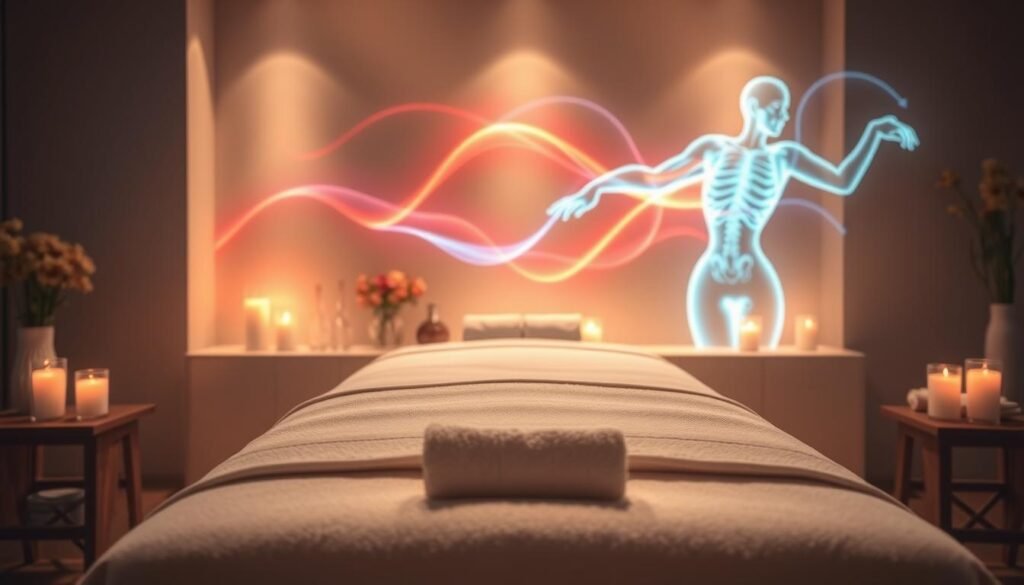
Regular glute massage offers many benefits for your body and well-being. It has greatly improved my muscle health and mobility.
One big benefit is reduced muscle tension. It helps work out knots and tight spots. This has given me significant relief from discomfort and improved flexibility. It also helps prevent delayed onset muscle soreness (DOMS) after hard workouts.
Another major advantage is improved glute mobility. Regular massage increases blood circulation to the area. This warms up the muscles and makes them more elastic. It leads to better muscle function and lowers the risk of injury during activities.
| Benefit | Impact |
|---|---|
| Reduced muscle tension | Less discomfort, improved flexibility |
| Improved blood circulation | Enhanced muscle warmth, better tissue elasticity |
| Decreased DOMS | Faster recovery after workouts |
| Removal of metabolic waste | Reduced fatigue and muscle ache |
Regular glute massage also helps remove metabolic waste like lactic acid from muscles. This reduces fatigue and muscle ache. It lets me keep up a consistent exercise routine.
“Glute massage has been a game-changer for my fitness journey. It’s not just about feeling good; it’s about maintaining healthy, functional muscles.”
Regular glute massage addresses many aspects. It enhances overall muscle function and contributes to a healthier, more mobile body.
Common Glute Issues and Pain Points
Knowing about common glute problems helps us avoid pain and injuries. I’ll look at three main issues that affect the glutes. These issues can impact our daily life and sports performance.
Muscle Tightness and Tension
Sitting for long periods and doing the same movements can make glutes tight. This tightness limits how well we can move and can hurt during exercise. Stretching and massage regularly can help loosen the muscles. This makes our glutes work better and reduces pain.
Delayed Onset Muscle Soreness (DOMS)
DOMS happens 24-72 hours after hard workouts, causing sore glutes. It makes moving hard and can mess up our training plans. Even though DOMS is normal, using the right recovery methods can make it heal faster and feel less painful.
Lower Back Pain
Glute problems often lead to lower back pain because they’re connected. Weak or tight glutes can change how we stand and move. This puts more stress on our lower back. Fixing glute issues with specific exercises and massage can greatly help our lower back.
| Issue | Symptoms | Relief Strategies |
|---|---|---|
| Muscle Tightness | Stiffness, limited range of motion | Stretching, foam rolling |
| DOMS | Soreness, tenderness to touch | Light exercise, massage |
| Lower Back Pain | Ache in lower back, discomfort when sitting | Glute strengthening, posture correction |
By understanding these common glute problems, we can prevent injuries and keep our hips and lower back healthy. Regular massage and specific exercises are key in solving these issues.
Preparing for a Glute Massage Session
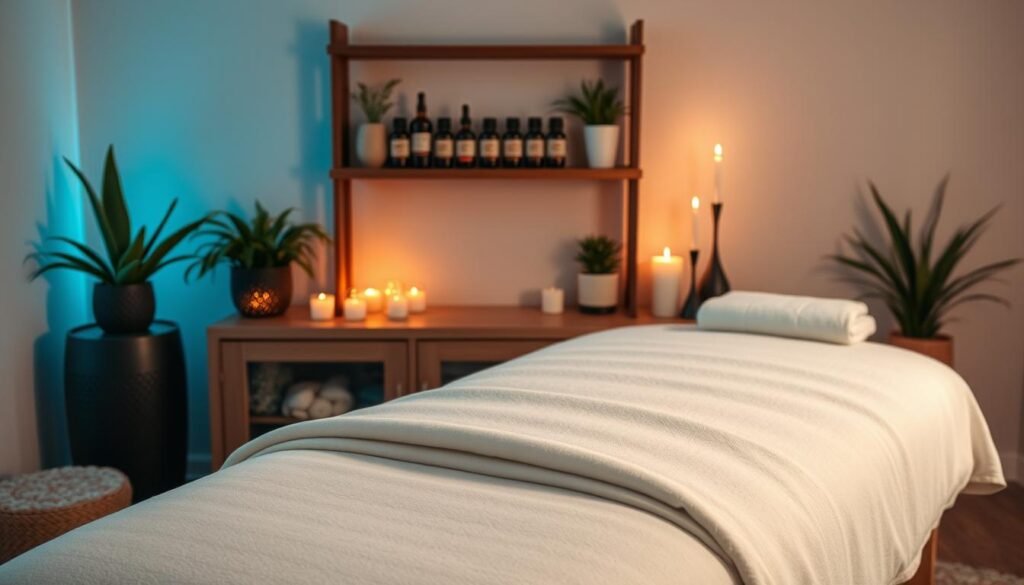
Getting ready for a glute massage is key for comfort and success. I start by making the room relaxing. I dim the lights, play soft music, and keep the room at a good temperature.
Learning to massage glutes means knowing how to drape properly. I have the client lie face down first. Then, I fold a sheet into a triangle to show the back and one side of the glutes. This keeps things modest while giving me access to the area.
To warm up the muscles, I use broad strokes. I start at the lower back and move down to the glutes. This relaxes the muscles and gets them ready for deeper work. It’s a crucial part of glute massage techniques.
“Proper preparation sets the stage for a successful massage session, ensuring both comfort and effectiveness.”
Here’s a quick checklist for preparing a glute massage session:
- Set up a comfortable massage table
- Gather necessary supplies (oils, towels)
- Ensure proper room temperature
- Dim lights and play soft music
- Review client’s health history
By following these steps, I create the perfect setting for a glute massage. This preparation lets me focus on giving the best massage experience.
How to Massage Glutes: Step-by-Step Techniques
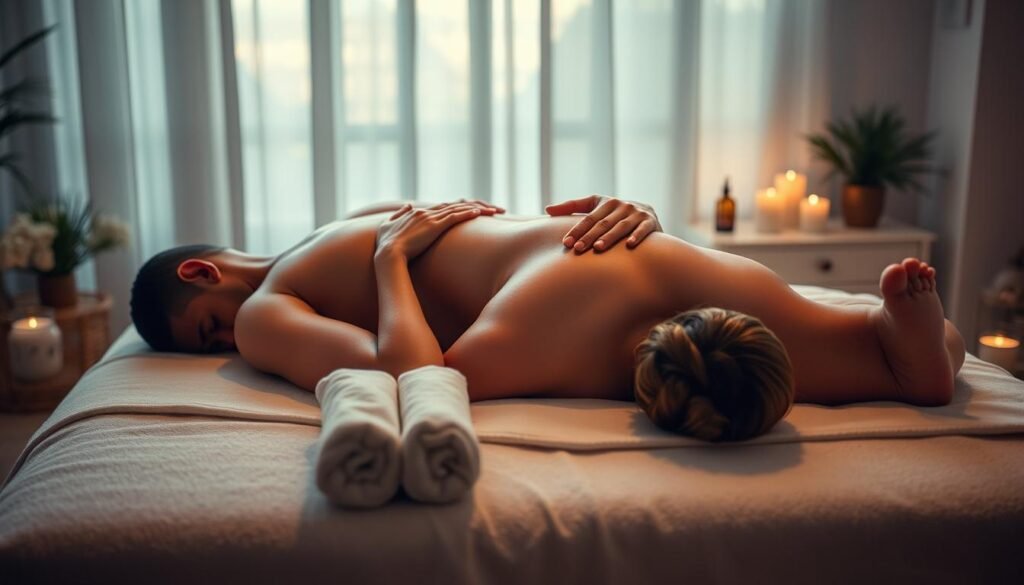
Learning to massage your glutes can ease muscle tension and boost lower body function. I’ll show you four essential methods for massaging your glutes effectively.
Compression Technique
Begin with compression. Place your palms on the gluteal muscles and apply firm, steady pressure. This step warms up the muscles and boosts blood flow, getting them ready for deeper work.
Kneading Technique
Then, knead the glutes like dough with your hands. Grab and squeeze the muscle, then release. This method loosens tight muscles and enhances circulation in the area.
Deep Strokes Technique
For deep strokes, use your flattened hands or fingertips to apply firm pressure. Move in long, slow strokes from the base of the glutes upward. This technique is great for easing muscle tightness and tension.
Trigger Point Release
Lastly, target trigger points – those knots of tension within the muscle fibers. Apply sustained pressure to these spots for 30-60 seconds or until you feel the tension release. This focused approach can offer significant relief from persistent tightness.
Start gently and gradually increase pressure as the muscles relax. By adding these glute massage techniques to your routine, you’ll enjoy looser, more comfortable muscles.
Self-Massage Techniques for Glutes
Self-massage for glutes is a great way to ease muscle tension and boost flexibility. I’ve discovered several effective glute massage techniques that you can do at home with little equipment.
One easy method is using your hands. I start by pressing with my fingertips or knuckles along my gluteus maximus muscle. I move from my lower back to my hip, using slow, careful motions.
For the gluteus medius and minimus, I focus on my hip’s side. Circular motions help loosen tension in these spots. This is especially helpful before and after working out to avoid soreness.
Using massage tools can make self-massage even better. A foam roller or massage ball is great. I lie on the tool and slowly roll over my glute muscles, stopping on tight spots for extra relief.
Effective Self-Massage Tools
| Tool | Best For | Technique |
|---|---|---|
| Foam Roller | Large muscle areas | Roll slowly, pausing on tight spots |
| Massage Ball | Targeted pressure points | Apply pressure and make small circular motions |
| Hands | Overall massage | Knead and apply pressure with fingers or knuckles |
Consistency is crucial with self-massage. I try to do short sessions every day. This helps keep my glutes flexible and prevents tightness.
Using Massage Tools for Glute Release
Glute massager tools have changed the game for self-massage. They target hard-to-reach spots and apply deeper pressure than hands can.
Foam Rollers
Foam rollers are my favorite for glute massage. I roll my hips over them to cover big muscle areas. It feels like a firm hug for my glutes.
Massage Balls
Massage balls are perfect for precise relief. I use tennis or lacrosse balls. Placing one under my glute and rolling helps target tight spots. It’s incredible how a small tool can offer such focused relief.
Percussive Therapy Devices
Percussive devices are my go-to for intense muscle release. They use rapid, deep compressions to boost blood flow and ease glute tension. They’re more expensive, but they’re worth it for deep muscle care.
FAQ
Why is glute massage important?
What are the different muscles in the gluteal region?
What are the benefits of regular glute massage?
What are some common glute issues that can be addressed with massage?
How should I prepare for a glute massage session?
What are some effective glute massage techniques?
How can I perform self-massage on my glutes?
What types of massage tools can be used for glute release?
Source Links
- Massage for Upper Gluteal Pain (Gluteus Maximus) – https://www.painscience.com/articles/spot-12-gluteus-maximus.php
- Buttock Massage – Massage For Body Parts – Massage – Treatments – https://www.physio.co.uk/treatments/massage/massage-for-body-parts/buttock-massage.php
- Hip and Glute Massage Sample Routine – http://themassagebusinessmama.com/hip-and-glute-massage-sample-routine/









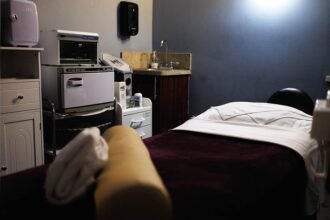

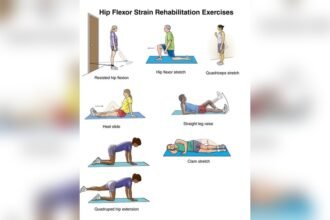
5 Comments
Arguably, the article couldve been improved with more visuals. Wouldve been easier to follow the glute massage techniques, dont you think?
Interesting article! But wouldnt effective glute massage techniques vary depending on a persons fitness level and muscular development?
Does anyone else think that the glute massage could benefit runners? Ive heard it can help with hip flexibility. Thoughts?
Interesting read, but does anyone know if these glute massage techniques can actually help with sciatica pain?
Interesting read! But, dont you think the gluteus minimus deserves some attention too? Its equally important in our movement and posture.